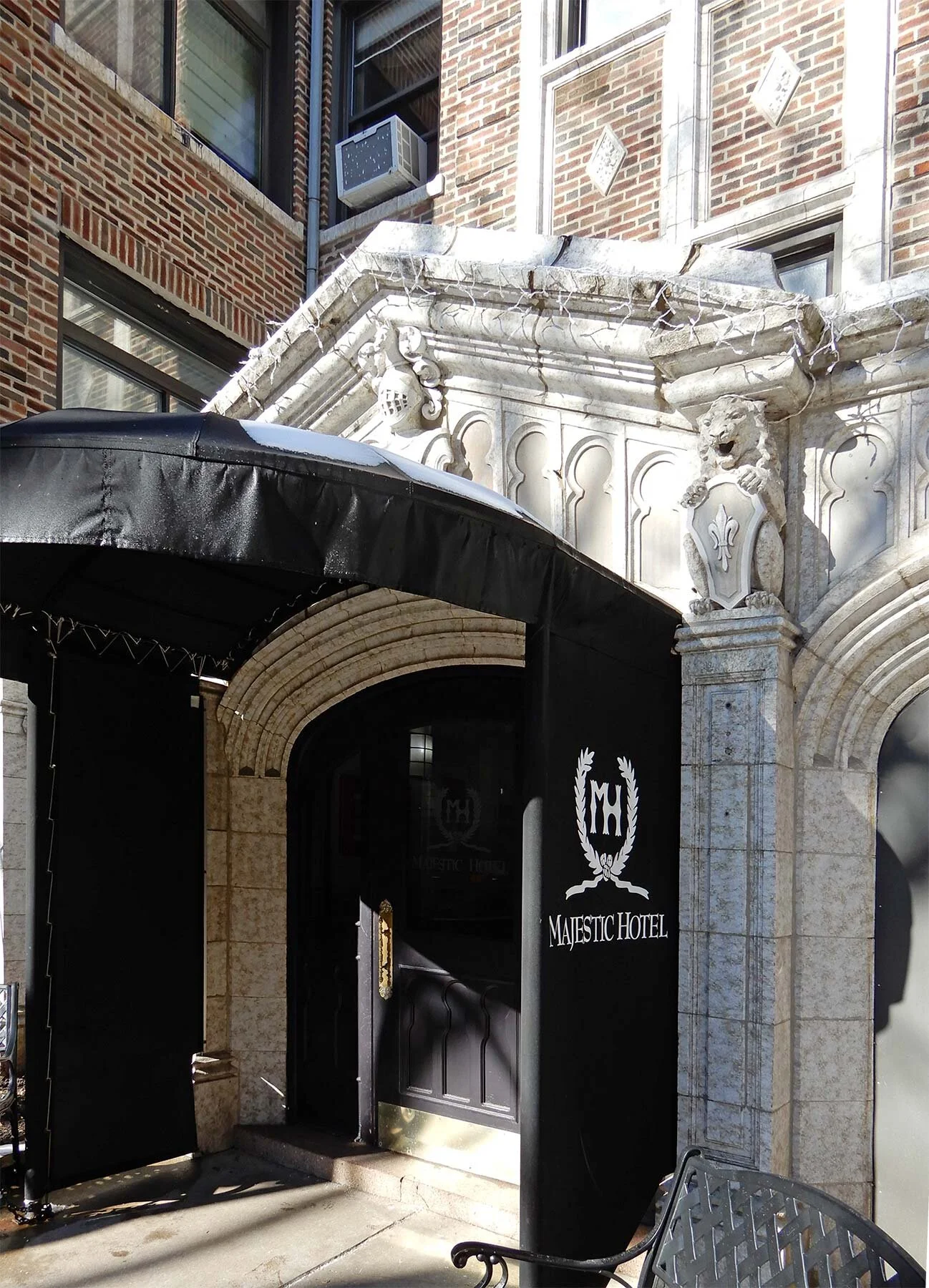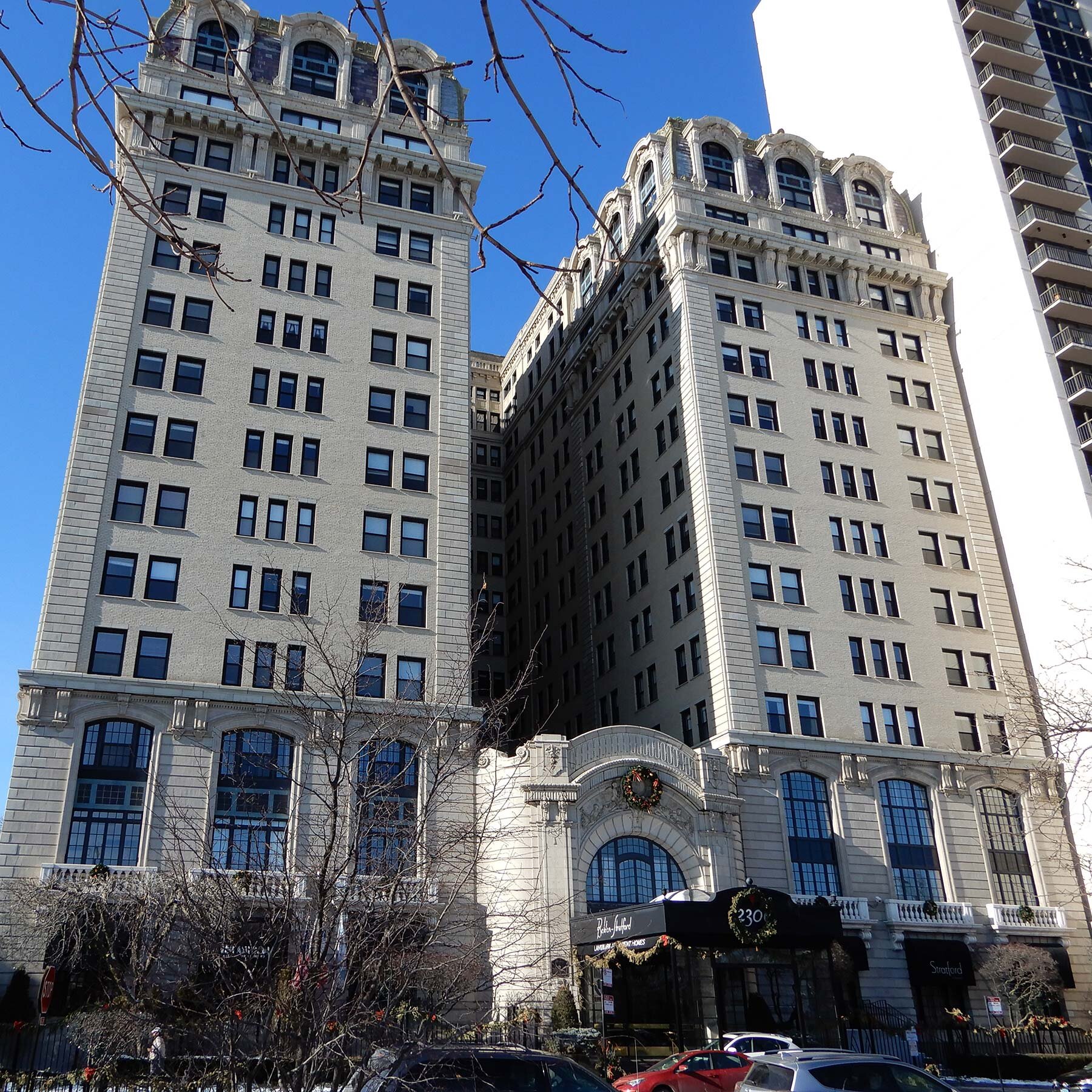The Belden Stratford was among Chicago’s many lavish apartment hotels of the 1920s. Photo by Julia Bachrach.
Last month, I discussed the emergence of apartment hotels in Chicago during the mid-1910s. These buildings, which offered a variety of amenities to middle-class tenants, gained quick popularity with local developers and renters. In fact, during the Roaring Twenties, hundreds of these structures were built throughout Chicago. This month I will explore the broad variety of 1920s apartment hotels including some ritzier examples located in exclusive residential neighborhoods.
The Belden Stratford fronts directly onto Lincoln Park. Chicago History Museum Hedrich-Blessing Collection, 1939, HB-O5472-B.
The Park Lawn Apartment Hotel was built at 1819 N. Humboldt Boulevard directly across Humboldt Park in the late 1920s. Photo by Julia Bachrach.
As I explained last month, a new type of apartment hotel was introduced in Chicago around 1915. Geared towards middle-class tenants, these facilities generally accommodated both short- and longer-term residents. With small units in attractive buildings, apartment hotels provided many Chicagoans of modest means the opportunity to live in desirable neighborhoods that they might not have otherwise been able to afford. Most, though not all, facilities of this type included small kitchenettes. They also often had a café or restaurant so that tenants wouldn’t have to do their own cooking. Apartment hotels offered an array of amenities such as maid, laundry, and concierge services; telephones in every suite; and billiard and smoking parlors, restaurants, and shops—all at affordable prices.
Two Women Playing Beach Ball at Clarendon Beach in the Uptown Community, 1916. Chicago History Museum, DN0066757.
Often built near parks, apartment hotels were especially popular in neighborhoods along the lakefront. Dozens of them opened in Uptown, a vibrant community with restaurants, entertainment venues, private beaches, and Clarendon Beach, a new municipal beach that could accommodate as many as 9,000 bathers per day.
Left: “Display Ad for Eastwood Beach Apartments” Chicago Tribune, March 12, 1925, p. 13. Right: Eastwood by the Lake, 811 W. EastwoodAvenue. Photo by Julia Bachrach.
Among Uptown’s early apartment hotels was the 1917 Eastwood Beach, a six-story building with 80 one- and two-room suites. This establishment offered tenants the choice of renting a furnished or an unfurnished apartment.
Its amenities included a lounge and reading room, breakfast room, ballroom, rooftop garden. Located in close proximity to Uptown beaches, the facility also provided shower rooms for lake bathers with individual lockers for residents and their guests. Architect John Nyden designed the structure in a restrained expression of the Classical style.
Eastwood Beach Apartment Hotel from Modern Apartment Hotels Thruout [sic] United States by Robert Carroll Cash, 1917.
Sheridan Plaza, 4607 N. Sheridan Road. Photo by Julia Bachrach
Some apartment hotels with in-house cafés and restaurants had units that lacked their own kitchen facilities. This was the case with the Sheridan Plaza, a 12-story apartment hotel that opened in Uptown in 1921. Architect Walter W. Ahlschlager not only designed the exuberant double-towered brick structure, but he co-developed and co-owned the 500-unit establishment.
Ahlschlager wrote a 1917 article in Hotel World magazine suggesting that kitchenettes are “small and overly compact,” as well as “unsanitary,” and therefore “undesirable except in the cheapest class of building.” The Sheridan Plaza, which was often advertised under “Hotels and Resorts” in the classified ads, had a cafeteria and restaurant, and offered room service. An ad titled “The Sheridan Plaza Way,” promoted the facility’s various dining options, stating that food prices were “very reasonable” and that meals would be ready “at any time you desire.
“Classified Ad,” Chicago Tribune, April 3, 1921, p. 94.
Close-up view of Palais Brompton (now Majestic Hotel). Photo by Julia Bachrach.
Apartment hotels without in-unit kitchen facilities were sometimes considered “bachelor’s apartments.” One example was the Palais Brompton, an establishment that opened near Lincoln Park at 528 W. Brompton Avenue in 1923. Architects Dubin & Eisenberg designed the 72-unit, four-story brick building and embellished its primary façade with fanciful, terra cotta Tudor-style details including lions, shields, and an armored figure.
The Palais Brompton was described as having “every known convenience including dining salon, lounge room, barber shop, and lobby on the main floor.” The facility also offered valet, bellboy, and daily maid services, as well as a telephone in every room. Ads stressed its “exceptionally attractive location,” within “easy walking distance” to Lincoln Park’s attractions such as golf and yachting.
Left: “Display Ad for Palais Brompton Bonds,” Chicago Tribune, December 10, 1922, p. A16. Right: The Palais Brompton is now the Majestic Hotel. Photo by Julia Bachrach.
The apartment hotel at 661 W. Sheridan Road is now called Anabelle Apartments. Photo by Julia Bachrach.
Advertisements for apartment hotels without full kitchenettes often touted the inclusion of “mechanical refrigeration” in every unit. This was the case with a seven-story building that opened at 661 W. Sheridan Road in 1927. Architect Raymond Gregori designed the structure, which features an eye-catching façade of tan brick with lively cream and green terra cotta ornamentation. Its tenants could choose from one- to four-room suites, either furnished or unfurnished. Ads stressed that this facility provided gas, light, and refrigeration for free.
Belden Stratford, 2300 N. Lincoln Park West. Photo by Julia Bachrach.
The prosperity of the 1920s spurred the development of spacious luxury rental and co-operative apartment buildings that catered to Chicago’s elite. As greater numbers of these impressive structures rose along the lakefront and in other exclusive residential neighborhoods, lavishly-appointed apartment hotels were often developed in these same areas. One example near Lincoln Park was the 1923 Belden Stratford. With a $4 million construction budget, the project led to one of the North Side’s most elegant buildings. It was produced by Meyer Fridstein, an architect who had previously worked for Marshall & Fox, the city’s premier designer of luxury apartments and hotels. Fridstein gave the Belden Statford a distinctly French flair by capping the structure with a prominent mansard roof. The exterior opulence is carried through the building’s fine interior public spaces, though the units themselves are quite simple.
Another North Side example was the Belmont Hotel. Designed by architects Fugard & Knapp, the 12-story structure had 693 rooms, including 250 apartment suites. According to an early advertisement, each of the apartments was to have a kitchenette with a sink, ice box, gas range, china closet, dishwasher, linen, silver, and dishes, with “maid service furnished as desired.” (There were 32 maids’ rooms in the apartment hotel.) The residential hotel also featured a cafe, a lounge, and a formal dining room with seating for 500, as well as a ballroom.
Belmont Hotel, 3170 N. Sheridan Road. Photo by Julia Bachrach.
The Belmont Hotel was a special place for many North Siders. Even those who didn’t stay or live there often attended special events in this establishment. Dozens of groups, including sororities, neighborhood organizations, Jewish groups, Masonic organizations, unions, and individuals hosted parties and other events there. In addition, North Siders frequently rented the Belmont Hotel’s ballroom and other spaces for wedding receptions, anniversary parties, and organizational meetings. Among the hundreds of special events held in the apartment hotel’s ballroom was the 1939 wedding of Esther Joan Solomon and Irv Kupcinet. (The groom would soon become one of Chicago’s most beloved newspaper columnists.)
“Display Ad for Belmont Hotel,” Chicago Tribune, April 6, 1924, p. 12.
Windermere Hotel, 1642 E. 56th Street. Photo courtesy of Antonio Vernon.
Other grand apartment hotels opened on the South and West Sides of the city. The Windermere Hotel opened at 1644 E. 56th Street in 1924. It was the work of Rapp & Rapp— architects known for designing “palace theaters”—and this grand building offers much of the same allure. In fact, it has an elegant vestibule that emulates the elaborate ticket booths of Rapp & Rapp-designed theaters. Altogether, the facility (sometimes referred to as Windermere East) provided more than 600 suites including many with kitchens, kitchenettes, and their own dining rooms. The building fronts onto Jackson Park and is in close proximity to the south lakefront.
On the West Side, the Guyon Hotel opened a couple of blocks west of Garfield Park in 1928. Designed in a Moorish Revival style, it was produced by architect Jens J. Jensen (1891- 1969), a Danish immigrant who had trained under Chicago architect Francis M. Barton. (This Jens Jensen should not be confused with the famous landscape architect.) The largest apartment hotel on the West Side, the ten-story building contained one- to four-room furnished kitchenette apartments.
Guyon Hotel, 4000 W. Washington Street. Photo by Julia Bachrach.
“Display Ad for Guyon’s Paradise Ballroom,” Chicago Tribune, October 9, 1927, p. W3.
Louis Guyon, a wealthy entrepreneur, owned a thriving West Side dance club with a 4,000-person capacity and its own radio broadcasting facilities. Describing himself as a “foe of Jazz,” Guyon only allowed what he considered “wholesome” styles of music and dance at his club. Despite its reputation as Chicago’s most conservative dance hall, Guyon’s Paradise Ballroom, which opened in 1916, was quite popular. (Located at 128 N. Pulaski Street, the building was destroyed by fire in the 1970s.) Guyon built his sprawling polychromatic apartment hotel directly south of the ballroom. Every room of Guyon’s 169-unit establishment had its own radio plug and speakers so that guests could enjoy the music broadcasted from his own WGES station or from other stations.
The Guyon Hotel is listed on the National Register of Historic Places. Although there have been attempts to rehabilitate this remarkable Revival-style edifice, sadly, it sits vacant and is tremendously deteriorated today. Since it’s so close to Garfield Park, I remember driving by this building over the years and wondering about it. I had heard of the Guyon Hotel before, but until I did the research for this essay, I didn’t realize that this lovely, but decaying structure was the formerly glorious Guyon Hotel. It is wonderful that so many other historic apartment hotels are still serving as residences and such a pity to see this one falling into decay.







![Eastwood Beach Apartment Hotel from Modern Apartment Hotels Thruout [sic] United States by Robert Carroll Cash, 1917.](https://images.squarespace-cdn.com/content/v1/58ab5d7bebbd1ab59c820b77/1578248614768-T3SDGWR546XY06BHWT6E/Eastwood-Beach-historic.jpg)










